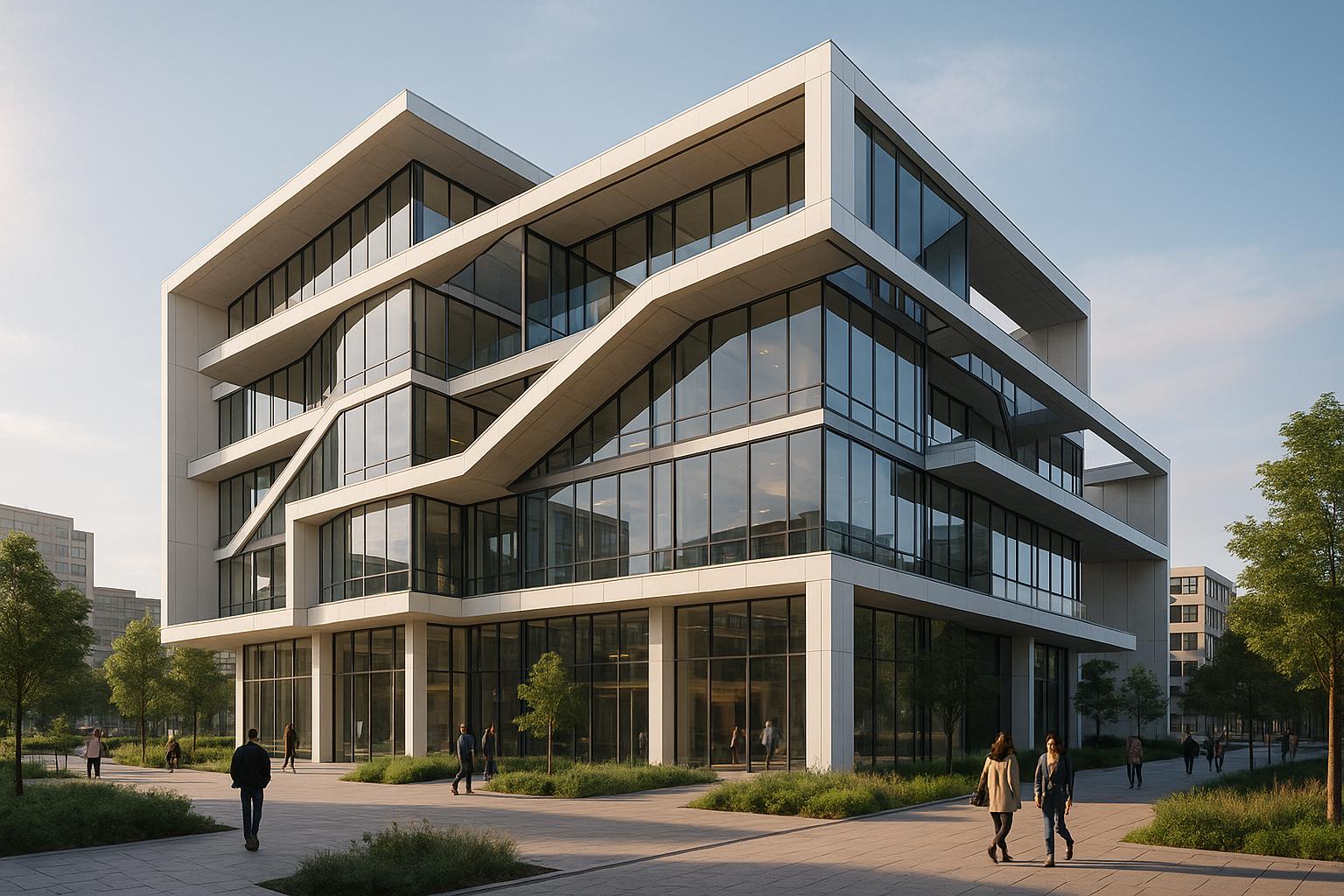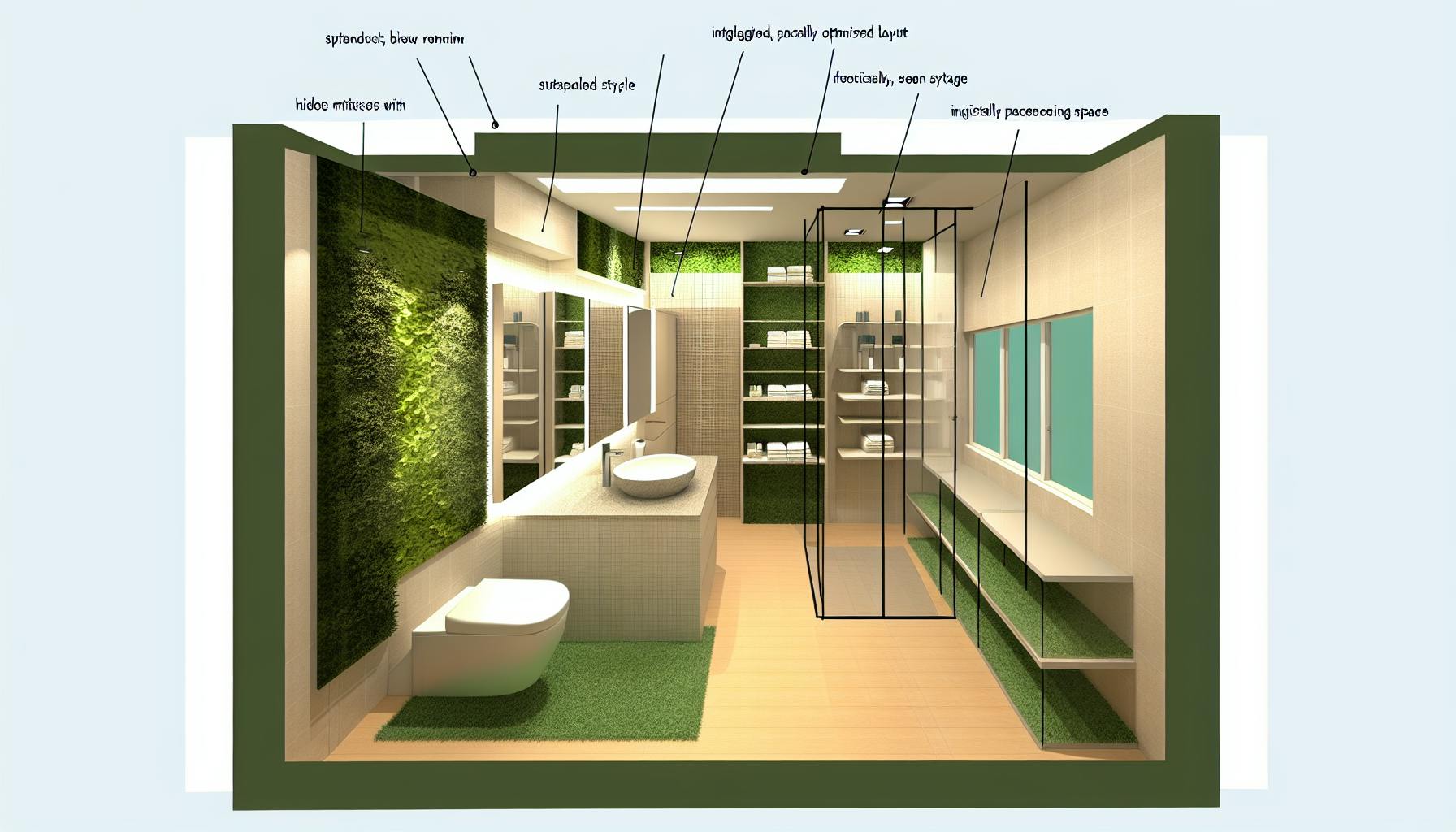Wind towers, also known as windcatchers or badgirs, are ancient architectural designs that naturally cool indoor spaces using wind. They reduce indoor temperatures by 14–22°F and provide up to 30 air changes per hour without electricity. Here’s why they matter today:
- Energy Savings: Air conditioning and fans consume 20% of global building electricity. Wind towers can cut a building's energy use by 23.3%.
- Environmental Impact: With cooling demand expected to triple by 2050, wind towers offer a sustainable alternative.
- Global Applications: Used in places like Iran, Egypt, and the UAE, they’ve inspired modern designs in shopping malls, universities, and public buildings.
Quick Overview:
- How They Work: Use wind pressure and stack effect to circulate air.
- Key Benefits: Lower energy costs, improve air quality, and reduce reliance on mechanical cooling.
- Modern Examples: Zion National Park Visitor Center (USA) and Council House 2 (Australia).
Wind towers combine ancient techniques with modern innovations, making them a practical, energy-efficient solution for today’s cooling needs.
Dr Susan Roaf: 'The Amazing Windcatchers of Yazd'
History and Types of Wind Towers
The origins of wind towers can be traced back to ancient Iran, with archaeological evidence suggesting their use as far back as 4000 BC. Early fire temples featured chimney-like structures that acted as primitive wind-catching systems, laying the groundwork for the many regional adaptations that followed.
Persian and Middle Eastern Beginnings
In Egypt, artwork near Luxor from around 1300 BCE depicts early wind tower designs atop Pharaoh Nebamun's residence. These evolved into the malqaf system, an early form of wind catcher. Similarly, in Iran, the badgir design emerged during the Achaemenid period, significantly influencing architectural practices across the Middle East.
"For centuries, before we had electricity, they made it possible to cool dwellings."
These innovations were not just functional but adaptable, evolving to suit the specific needs of various regions.
Regional Variations of Wind Towers
Different regions developed distinct wind tower designs to tackle their unique environmental challenges. Here's a closer look at how these structures adapted to local climates:
| Region | Type | Design Features | Climate Adaptation |
|---|---|---|---|
| Iran | Badgir | Multi-directional, with 4–8 sides, reaching heights of up to 112 ft | Built to withstand dust storms and extreme heat |
| Egypt | Malqaf | Bi-directional, shorter and wider | Utilized evaporative cooling for hot, dry conditions |
| UAE | Barjeel | Square base (approx. 8.2 × 8.2 ft), four-sided | Optimized for coastal winds and high humidity |
| Iraq | Traditional | Multiple towers with inward-facing scoops | Designed to channel air efficiently indoors |
One of the most iconic examples of Persian wind towers is found at the Dowlat Abad Garden in Iran. Its eight-sided structure, standing approximately 112 ft (34 m) tall, directs airflow over a rocky pool to amplify cooling effects.
"The design of ventilation systems is critical and important for buildings, particularly in housing designs. The designs of wind catchers changes in response to regional climatic conditions, criteria and consideration of ventilation."
Modern Influence
The principles behind these ancient wind towers continue to inspire modern architecture. Between 1979 and 1994, for instance, nearly 7,000 variations of wind catchers were installed in public buildings across the UK, including the Royal Chelsea Hospital in London. These timeless designs remain a testament to the ingenuity of ancient builders, bridging the gap between traditional methods and today's focus on energy-efficient and sustainable architecture.
Wind Tower Design and Function
Wind towers combine clever architectural design with natural physics to create efficient passive cooling systems. By using air movement and temperature differences, they maintain comfortable indoor climates without needing mechanical systems. These structures are rooted in ancient techniques but have been refined for energy-conscious modern applications.
Air Flow and Temperature Control
Wind towers regulate indoor temperatures through a combination of natural airflow and thermal dynamics. Here’s how it works: when wind enters the tower’s openings, it produces positive pressure on the windward side and negative pressure on the leeward side. This pressure difference drives air through the building. At a wind speed of 160 feet per minute, this airflow can lower perceived temperatures by up to 5°F. When paired with the stack effect - where warm air rises and exits through the top of the tower - it can achieve cooling of 14–22°F and up to 30 air changes per hour.
| Cooling Mechanism | Process | Impact |
|---|---|---|
| Wind-Driven Flow | Air movement caused by pressure differences | Improved comfort through better circulation |
| Stack Effect | Warm air exits through the top of the tower | Helps maintain cooler indoor temperatures |
| Combined Systems | Incorporates water features or underground channels | Boosts overall cooling efficiency |
Building Materials and Methods
The materials and construction methods used in wind towers are critical to their performance. Modern designs often blend innovative materials with traditional techniques, aiming to reduce reliance on nonrenewable energy sources.
Key factors influencing performance include:
- Tower Height: Taller towers capture cooler, stronger winds.
- Cross-Sectional Design: Square profiles enhance airflow efficiency.
- Internal Configuration: Dividers and filters improve airflow while reducing dust.
Wind towers are often integrated with additional building elements for maximum efficiency. A great example is Council House 2 in Melbourne, Australia, which uses "shower towers" - three-story structures with wet cloths to amplify evaporative cooling.
Modern advancements have further improved wind tower efficiency through:
- The use of transparent materials to allow more natural light.
- Integration with solar chimneys for enhanced ventilation.
- Sensor-controlled components to adjust airflow automatically.
- Specialized filters to manage dusty environments.
These innovations have led to a 23.3% reduction in total building energy consumption. However, their success depends heavily on proper orientation, alignment with prevailing winds, and consideration of local climate conditions. These thoughtful material and design choices showcase how wind towers remain a practical solution for modern, energy-efficient architecture.
Wind Towers in Current Architecture
Modern Wind Tower Systems
Today's wind tower systems have gotten smarter and greener. They often include sensor-controlled components and solar-powered fans that optimize natural ventilation while cutting down on the need for mechanical cooling. This is especially crucial in places like Egypt, where air conditioning accounts for a staggering 60% of peak electricity usage. These systems aren't just theoretical - they're being successfully implemented in projects around the globe.
Recent Building Examples
The effectiveness of these systems is evident in several cutting-edge buildings. Here are a few standout examples:
| Building | Location | Features | Impact |
|---|---|---|---|
| Zion National Park Visitor Center | Utah, USA | Natural ventilation system | Drastically reduces mechanical cooling |
| Council House 2 | Melbourne, Australia | Three-story evaporative cooling towers | Major decrease in energy use |
| Zénith de Saint-Étienne | France | Large aluminum windcatcher | Boosts natural airflow |
| Bluewater Shopping Centre | Kent, UK | Multiple windcatcher towers | Better indoor air circulation |
Take the Zion National Park Visitor Center in Utah, for instance. Situated in a desert climate, it uses a wind tower system that nearly eliminates the need for traditional air conditioning.
These systems aren't just about comfort - they're about efficiency. Modern wind towers can produce up to 30 air changes per hour, ensuring a steady flow of fresh air. Plus, they can cool indoor spaces by 8 to 12°C (14 to 22°F) compared to the outdoor temperature. This makes them a game-changer, especially in regions with scorching climates.
As energy concerns rise and sustainability becomes more critical, architecture firms are increasingly turning to wind towers. They offer a smart alternative to traditional air conditioning, particularly in areas where cooling demands strain energy resources. Wind towers are no longer just a nod to the past - they're paving the way for a more energy-conscious future.
sbb-itb-1be9014
Wind Tower Performance
Power Use and Cost Impact
Wind towers significantly reduce energy use by leveraging passive cooling techniques. With buildings consuming around 60% of the world's electricity - and cooling alone accounting for nearly 20% of that - wind towers provide a much-needed solution. Depending on their design, these systems can lower electrical energy consumption by an impressive 20–80%.
Take a look at some real-world examples of their impact:
| Building | Energy Savings | Cost Impact |
|---|---|---|
| CII-Godrej GBC, Hyderabad | 55% less energy than conventional buildings | Pre-cools incoming air by about 12–14°F |
| Torrent Research Centre, Ahmedabad | 200-ton reduction in AC capacity | Payback period of less than one year |
The Torrent Research Centre's use of a Passive Downdraft Evaporative Cooling (PDEC) system with wind towers is especially noteworthy. This setup not only cut electricity costs dramatically but also allowed the initial investment to be recouped in under a year. These examples highlight the potential of wind towers to transform energy efficiency and cost-effectiveness in building design.
Climate and Comfort Effects
Wind towers are not just about energy savings - they also excel at maintaining comfortable indoor climates, even in challenging conditions. They are most effective when there's an 18–27°F difference between indoor and outdoor temperatures. For context, wind towers deliver 5.14 air changes per hour, which is 40% more than traditional air conditioning systems. They also keep indoor temperature shifts within a narrow 5–7°F range over 24 hours, even when outdoor temperatures fluctuate by 25–31°F. Occupants in buildings equipped with wind towers report satisfaction rates of 74–100%.
For example, at the Torrent Research Centre, where outdoor temperatures can soar to 111°F, indoor temperatures are maintained at a much cooler 88–90°F - a drop of 22°F. With air conditioning demand expected to double by 2050, these figures show just how vital wind towers could become in managing energy use and maintaining comfort.
"Cooling is increasingly in demand in buildings, especially as the climate gets hotter. There might be inclusion of mechanical systems, but how can we cool buildings to begin with - before relying on the mechanical systems?"
- Omar Al-Hassawi, Assistant Professor at WSU's School of Design and Construction
Additionally, in urban environments where windows often aren’t practical, wind towers enhance air circulation, improving overall air quality. This dual benefit of temperature regulation and better air quality makes them an increasingly appealing option for modern architecture.
Wind Tower Analysis with Architecture Helper
Architecture Helper offers advanced tools that dive deep into the design of wind towers, from traditional airflow systems to cutting-edge adaptations. These tools combine the wisdom of age-old designs with modern simulations, offering a clear view of how traditional concepts can align with today’s energy-efficient strategies.
Design Analysis Tools
Architecture Helper simplifies the evaluation of wind tower designs by breaking down their key features:
| Design Feature | Analysis Capability | Observed Performance Impact |
|---|---|---|
| Cross-sectional Shape | Geometric pattern recognition | Square designs tend to outperform round ones by encouraging better flow separation. |
| Tower Height | Dimensional analysis | Properly optimized height significantly boosts air exchange efficiency. |
| Internal Divisions | Structure mapping | Dividing the tower internally can lead to improved airflow distribution. |
With its visualization tools, Architecture Helper identifies critical design elements, such as internal channeling systems that create a Venturi effect, boosting airflow efficiency. For instance, modern wind towers that incorporate wetted surfaces have been found to lower indoor temperatures by as much as 22°F compared to the outside environment.
The platform also includes an extensive design library, featuring case studies of successful wind tower installations. By blending traditional principles with updated performance data, these resources help architects refine their designs for better results. Here’s how the tools bring clarity to design optimization:
- Flow Pattern Analysis: Simulations of fluid dynamics reveal that one- and two-sided wind tower designs outperform multi-sided configurations in terms of airflow efficiency.
- Thermal Performance Mapping: Thermal analysis highlights how well-designed and properly oriented wind towers can significantly cut energy usage.
- Integration Assessment: Studies show that wind towers perform best when paired with passive cooling features like shaded courtyards or underground cooling systems.
Looking Ahead: Wind Towers Tomorrow
The future of wind towers is all about blending advanced technology with smart systems to create more efficient and sustainable cooling solutions. With tools like Computational Fluid Dynamics (CFD), engineers can now fine-tune airflow and thermal performance, paving the way for hybrid cooling systems that deliver greater efficiency.
Here's a closer look at some innovations shaping the next generation of wind towers:
| Innovation | Impact | Implementation Timeline |
|---|---|---|
| AI-Powered Design | Improves tower geometry and placement | Currently emerging |
| Hybrid Systems | Combines with heat pumps and solar chimneys | In development |
| Smart Controls | Automates adjustments to weather changes | Near-term adoption |
One exciting development is integrating wind towers with evaporative cooling systems, which can cut traditional energy consumption by as much as 52% while enhancing thermal comfort. Small wind turbines are another promising addition. By 2027, this market is projected to hit $309 million, with these turbines potentially covering 10-20% of energy needs for tall buildings in urban areas.
Other integration trends include:
- Solar chimney systems to boost airflow when wind levels are low
- Evaporative cooling elements for better temperature control
- Smart sensors that adjust performance based on real-time data
As urban areas grow denser, wind towers are evolving to fit seamlessly into cityscapes. With smarter controls and adaptable designs, they’re not just staying relevant - they’re becoming essential. These modern designs merge effortlessly with contemporary architecture while staying true to their primary purpose: delivering sustainable cooling solutions.
FAQs
How do wind towers help reduce energy use in buildings?
Wind towers, also known as windcatchers, offer a smart way to cool buildings without relying on traditional air conditioning. By directing natural wind into indoor spaces, they boost ventilation and help maintain comfortable temperatures. This approach can cut down on electricity use, especially during those sweltering summer months.
Today’s wind tower designs take things a step further. With modern architectural advancements, they’re built to optimize airflow and improve cooling efficiency. Beyond saving energy, these structures align with eco-friendly building practices by reducing their environmental footprint. Wind towers are a clever blend of age-old techniques and modern energy-saving strategies.
How do traditional wind towers differ from modern designs in passive cooling?
Traditional wind towers, often called windcatchers, are vertical structures designed to cool buildings naturally by directing outdoor breezes inside. These towers, commonly seen in hot regions like the Middle East, are built using local materials and tailored to suit the specific climate. Their design is straightforward, with fixed openings that focus purely on functionality - a method that has proven effective for centuries.
In contrast, modern wind towers take this concept further by incorporating advanced materials and cutting-edge technologies. Features like adjustable vents, solar chimney integration, and transparent materials for natural lighting make these designs more efficient at managing airflow and energy use. While traditional wind towers emphasize simplicity and local solutions, modern versions are designed to meet today's sustainability goals and function effectively in a broader range of environments.
How do wind towers help keep buildings cool in extreme climates?
Wind towers, also known as windcatchers, offer a smart and eco-conscious way to cool buildings, particularly in hot, arid regions. By channeling outdoor air into indoor spaces, they create natural ventilation that can lower indoor temperatures by an impressive 25–30%. This not only helps to cool the space but also enhances air circulation, leading to better indoor air quality.
The design of wind towers relies on the stack effect - a natural phenomenon where warm air rises and escapes, allowing cooler air to flow into the building. This passive cooling system significantly cuts down the need for energy-draining air conditioning, providing a more sustainable way to stay comfortable even in extreme heat. Plus, their ability to adapt to various climates showcases their practicality in contemporary architectural designs.


